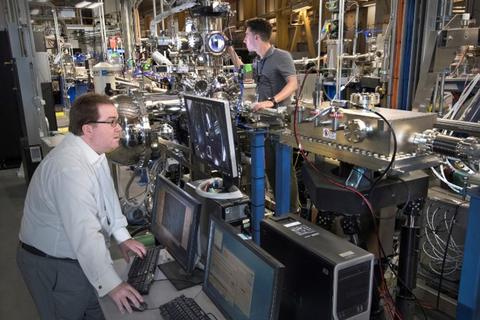Hard X-ray Photoelectron Spectroscopy (HAXPES)

Instrument scientists Conan Weiland (left) and Nick Quackenbush (right) at the Hard X-ray Photoelectron Spectrometer (HAXPES).
The Hard X-ray Photoelectron Spectroscopy (HAXPES) end station uses a tunable, focused X-ray beam in the tender spectrum (2.0 keV to 7.5 keV) to probe the depth dependent chemical, electronic, and molecular structure near the surface of materials. While often categorized as an end station on SST-II, the HAXPES end station can receive beam from both SST-II (2.0 keV to 7.5 keV) and SST-I (0.1 keV to 2.2 keV) at a single spot, providing a capacity to measure a very wide range of depth (1 to 10 nm below the surface) and element specific chemical and electronic environments. The spot size at the sample can be focused to as small as 50 μm. Photoelectrons emitted are collected using a 400 mm diameter concentric hemispherical analyzer. The end station also features a channeltron detector and capabilities for total electron yield (TEY) mode for X-ray adsorption spectroscopy.
As with all X-ray Photoelectron Spectroscopy (XPS) techniques, the X-ray beam excites core electrons with excitation energies below the incident X-ray energy. In contrast to lab based equivalents, which often use a fixed source wavelength, the depth of measurement and elements excited can be controlled through tuning the incident energy of the beam. The high intensity of the source enables optics to provide a focused beam on the sample, enabling the probe of small samples or small areas on heterogeneous samples. Higher X-ray energies increase the kinetic energy of the photoelectrons, providing information from depths down to 10 nm below the surface.
The HAXPES end station is located on the Spectroscopy Soft and Tender (SST-II) beamline, one of three beamlines built, designed, and operated by NIST in partnership with Brookhaven National Laboratory at the National Synchrotron Light Source (NSLS-II). When using the soft X-ray spectrum, the technique is sometimes referred to as Soft X-ray Photoelectron Spectroscopy (SXPS).
Specifications/Capabilities
Energy range: Tender beam - 2.0 keV to 7.5 keV; Soft beam - 0.1 keV to 2.2 keV
Spot Size: 50 μm
Detectors: 400 mm diameter concentric hemispherical analyzer, channeltron detector
Usage Information
Operating Schedule
HAXPES is currently in commissioning, and is anticipated to be available for general users in 2019.
Access Information
All users are encouraged to discuss potential experiments with the relevant instrument scientist prior to applying for access. After commissioning is complete, access to HAXPES will be granted based on merit of the proposed experiment through one of two mechanisms:
1) General users may apply for time through the general user program at NSLS-II. Qualifications, proposal templates, and guidelines are available at https://www.bnl.gov/ps/userguide/.
2) For NIST staff only: NIST projects may request access for experiments by contacting the instrument scientists listed here. Requests are collected and reviewed by the NIST BNL allocation committee and granted time based on merit and fit to the NIST mission. For more information, contact an instrument scientist listed here.

